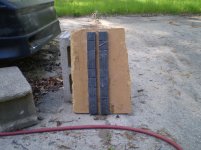I assume that your intended purpose id diaphragm coating? If so you want a resistive ink not a conductive one. Hundreds of megohms per square are what you are after. Think Quads nylon coating which could absorb just enough moisture to conduct static forget the exact ohm value but very high. This keeps charge from migrating at anywhere near audio frequencies of it your diaphragm slaps a stator then only local charge can jump to ground. Static dissipating coatings are in the range required for electrostatic loudspeakers. Best regards Moray James.
in that case you will not be able to find ink with a high enough conductivity. not saying that you could not get something to work just that it will be painfully low in efficiency. The other problem low conductivity traces will cause is a lot of heat. What kind of diaphragm material do you want to use? You can look into the thermal capacity of your choice of film. Kapton is the best for taking heat. You can electro deposit, vapour deposit and sputter copper onto Kapton (as far as I know). Look into the companies which design and make flexible heating elements. You could have a kapton section with the VC on it and flank that with softer Mylar which has more loss and so less resonance. Have you got an overall design in mind? Best regards Moray James.
I've thought of doing the opposite - starting with metalised plasstic film and etching away the unwanted metal.I am thinking of direct conductor printing for magnetic planar loudspeakers.
Apparently conductive paint does exist and is used e.g. to repair windscreen demisters. The only stuff I could actually find was silver based and very expensive, though.
I have tried using conductive ink to make a ribbon tweeter and I had Two issues,
First, It was difficult and almost impossible to get the ink to properly adhere to the Mylar.
Second, I couldn't get the ink to flow out thin enough so weight became an issue, However this may work okay for a bass panel but it will be very very costly, as conductive ink prices have shot through the roof since 2004 or so.
Especially Silver!!
I tried a few plating techniques with copper as well but this turned out a very heavy ribbon that was very brittle.
But with a glue and graphite base on the Mylar it did work but i never pursued it anymore after that.
I used Circuit Works ink in my experiment and it seemed to be a silicone based as it is very soft and flexible but it peeled right off of my Mylar base strip.
A primer glue did help with this, the type you find in metal leaf kits, But weight was the major issue.
I too have some Metalized Mylar and I have found that an etching process will work but I haven't made diaphragm for a speaker using it yet.
My only concern with the material is that the aluminium coating is very very thin and doesn't handle very large amounts of current at all by some of the simple test I have done.
A headphone build may be a better choice using the stuff.
I still have the stuff and have been wanting to give it a real try but I don't have enough magnets too build even a small structure.
As all of the ones I have are already super glued together from my experiments in the 90's of the above description.
jer
First, It was difficult and almost impossible to get the ink to properly adhere to the Mylar.
Second, I couldn't get the ink to flow out thin enough so weight became an issue, However this may work okay for a bass panel but it will be very very costly, as conductive ink prices have shot through the roof since 2004 or so.
Especially Silver!!
I tried a few plating techniques with copper as well but this turned out a very heavy ribbon that was very brittle.
But with a glue and graphite base on the Mylar it did work but i never pursued it anymore after that.
I used Circuit Works ink in my experiment and it seemed to be a silicone based as it is very soft and flexible but it peeled right off of my Mylar base strip.
A primer glue did help with this, the type you find in metal leaf kits, But weight was the major issue.
I too have some Metalized Mylar and I have found that an etching process will work but I haven't made diaphragm for a speaker using it yet.
My only concern with the material is that the aluminium coating is very very thin and doesn't handle very large amounts of current at all by some of the simple test I have done.
A headphone build may be a better choice using the stuff.
I still have the stuff and have been wanting to give it a real try but I don't have enough magnets too build even a small structure.
As all of the ones I have are already super glued together from my experiments in the 90's of the above description.
jer
Attachments
- Status
- This old topic is closed. If you want to reopen this topic, contact a moderator using the "Report Post" button.
- Home
- Loudspeakers
- Planars & Exotics
- Conductive inks
